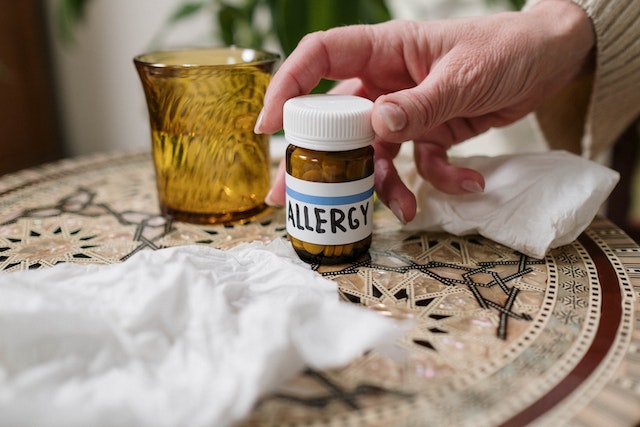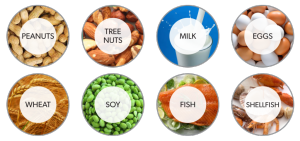Category Archives: Food Allergies
Understanding Food Allergies
 Food allergies are immune system responses to certain foods that the body mistakenly identifies as harmful. These reactions can range from mild to severe and can affect various parts of the body. Here’s what you need to know:
Food allergies are immune system responses to certain foods that the body mistakenly identifies as harmful. These reactions can range from mild to severe and can affect various parts of the body. Here’s what you need to know:
Understanding Food Allergies
1. Common Allergens
The most common food allergens, often referred to as the “Big Eight,” include milk, eggs, peanuts, tree nuts, soy, wheat, fish, and shellfish. These foods account for the majority of allergic reactions.
2. Symptoms
Symptoms of food allergies can vary widely and may include hives, swelling, stomach pain, vomiting, diarrhea, respiratory issues, and anaphylaxis—a severe, potentially life-threatening reaction. Symptoms usually appear within minutes to a few hours after consuming the allergen.
3. Diagnosis
Diagnosing food allergies typically involves a combination of medical history, dietary review, skin prick tests, blood tests, and oral food challenges. An allergist will evaluate these results to confirm the allergy.
4. Managing Food Allergies
The primary way to manage food allergies is strict avoidance of the allergen. This requires careful reading of food labels, awareness of cross-contamination risks, and clear communication with restaurants and food preparers. In case of accidental exposure, individuals should have an emergency action plan, which includes carrying epinephrine auto-injectors.
5. Living with Food Allergies
Living with food allergies involves being proactive and prepared. It’s important to educate family, friends, and caregivers about the allergy and how to recognize and respond to symptoms. Joining support groups and staying informed about new treatments and research can also help.
Understanding Food Allergies: Conclusion
Understanding and managing food allergies is crucial for ensuring safety and maintaining quality of life. By knowing common allergens, recognizing symptoms, and having a solid management plan, individuals with food allergies can effectively navigate their daily lives.
For comprehensive food allergy diagnosis and management, contact Dr. Boyan Hadjiev at Allergy, Asthma and Sinusitis P.C. Our team is committed to providing expert care and personalized treatment plans.
Boyan Hadjiev, MD
212-319-5282
Understanding Food Allergies: Tips from a Top Food Allergist in NYC
 Should you consult a food allergist? Food allergies can be a serious and life-altering condition, affecting millions of people in the United States. In a bustling metropolis like New York City, where dining out and culinary experiences are an integral part of life, understanding and managing food allergies becomes even more crucial. That’s where Dr. Boyan Hadjiev, a top food allergist in NYC, comes in. Known as “Dr. Sneeze,” he specializes in helping individuals navigate the complex world of food allergies and lead healthier lives. In this blog post, we will explore the key aspects of food allergies and share valuable tips from Dr. Sneeze to help you or your loved ones better manage this condition.
Should you consult a food allergist? Food allergies can be a serious and life-altering condition, affecting millions of people in the United States. In a bustling metropolis like New York City, where dining out and culinary experiences are an integral part of life, understanding and managing food allergies becomes even more crucial. That’s where Dr. Boyan Hadjiev, a top food allergist in NYC, comes in. Known as “Dr. Sneeze,” he specializes in helping individuals navigate the complex world of food allergies and lead healthier lives. In this blog post, we will explore the key aspects of food allergies and share valuable tips from Dr. Sneeze to help you or your loved ones better manage this condition.
What Are Food Allergies?
Food allergies are immune system reactions triggered by specific proteins in certain foods. When someone with a food allergy consumes the allergen, their immune system mistakenly identifies it as harmful and releases chemicals, such as histamines, to protect the body. This immune response can lead to a range of symptoms, from mild to severe, including:
- Hives or skin rash
- Swelling of the face, lips, tongue, or throat
- Difficulty breathing
- Abdominal pain
- Nausea and vomiting
- Diarrhea
- Anaphylaxis, a severe and potentially life-threatening reaction that can cause a drop in blood pressure and loss of consciousness
Common Food Allergens
While any food can potentially cause an allergic reaction, eight major allergens are responsible for the majority of food allergy cases. These include:
- Milk
- Eggs
- Peanuts
- Tree nuts
- Soy
- Wheat
- Fish
- Shellfish
Diagnosing Food Allergies
Accurate diagnosis of food allergies is essential for effective management. Dr. Sneeze offers comprehensive allergy testing, including skin prick tests and blood tests, to identify specific allergens triggering your symptoms. If you suspect a food allergy, seek professional medical advice rather than attempting self-diagnosis.
Understanding Food Labels
Reading food labels is a crucial skill for anyone with food allergies. Dr. Sneeze advises his patients to:
- Carefully read ingredient lists for potential allergens.
- Be aware of hidden sources of allergens, such as cross-contamination in shared kitchen equipment.
- Understand labeling terms like “may contain,” “processed in a facility that also processes,” and “contains.”
Creating a Safe Eating Environment
Dr. Sneeze recommends the following steps to create a safe eating environment when you have food allergies:
- Inform Others: Educate your friends, family, and dining companions about your food allergies. They should be aware of the seriousness of the condition and how to respond in case of an allergic reaction.
- Carry Medications: Always carry prescribed epinephrine auto-injectors (e.g., EpiPen) and antihistamines. These can be lifesaving in case of an allergic reaction.
- Communication is Key: When dining out, communicate your allergies to restaurant staff, including chefs and servers. Ask questions about ingredients, food preparation methods, and potential cross-contamination risks.
- Plan Ahead: Plan your meals and snacks carefully to ensure you have safe options readily available. This includes packing safe snacks when traveling or attending events.
Food Allergist: Seeking Professional Guidance
Managing food allergies can be challenging, but with the right guidance, it becomes much more manageable. Dr. Sneeze and his team specialize in helping individuals develop personalized strategies for coping with food allergies. They can provide:
- Allergy testing to identify specific allergens
- Guidance on allergen avoidance
- Emergency action plans for severe reactions
- Education on reading food labels
- Immunotherapy for potential desensitization
Contact NYC’s Leading Food Allergist: Dr. Boyan Hadjiev
Don’t let food allergies limit your enjoyment of life in the Big Apple. Dr. Boyan Hadjiev, known as “Dr. Sneeze,” is here to help you understand and manage food allergies effectively. Dr. Sneeze is NYC’s leading allergist, providing expert care and guidance for individuals with food allergies.
To schedule an appointment or seek assistance, contact Dr. Sneeze today:
Dr. Boyan Hadjiev
Allergy, Asthma and Sinusitis P.C.
30 East 40th Street, Suite 1200
New York, NY 10016
Call 212-319-5282 or visit https://drsneeze.com for more information.
Take control of your food allergies and enjoy a safer, healthier life!
Food Allergies: Common Triggers and Effective Treatment Options in 2023-2024
Food allergies are a growing concern in the United States, with an estimated 32 million Americans affected. If left untreated, food allergies can cause serious health problems, including anaphylaxis. That’s why it’s important to seek medical attention if you suspect that you have a food allergy. Boyan Hadjiev MD, an allergist located in New York City, can help you identify the triggers of your food allergies and provide effective treatment options. In this blog post, we’ll discuss common food allergy triggers and how Dr. Hadjiev can help you manage them.

Common Food Allergy Triggers
The most common food allergies are to peanuts, tree nuts, milk, eggs, soy, wheat, fish, and shellfish. However, it is possible to be allergic to any food. Symptoms of a food allergy can range from mild to severe and can include hives, swelling, abdominal pain, vomiting, diarrhea, and difficulty breathing.
Peanuts and Tree Nuts
Peanuts and tree nuts are among the most common food allergens. People who are allergic to peanuts may also be allergic to tree nuts, such as almonds, walnuts, and cashews. Symptoms of a peanut or tree nut allergy can range from mild to severe and can include anaphylaxis, a life-threatening reaction.

Milk, Eggs, and Soy
Milk, eggs, and soy are also common food allergens. Symptoms of a milk allergy can range from mild to severe and can include hives, abdominal pain, and vomiting. Symptoms of an egg allergy can include hives, abdominal pain, and difficulty breathing. Soy allergy symptoms can range from mild to severe and can include hives, abdominal pain, and anaphylaxis.
Fish, Shellfish & Wheat
Wheat, fish, and shellfish are other common food allergens. Wheat allergy symptoms can range from mild to severe and can include hives, abdominal pain, and anaphylaxis. Fish allergy symptoms can include hives, swelling, and difficulty breathing. Shellfish allergy symptoms can range from mild to severe and can include hives, abdominal pain, and anaphylaxis.
Effective Treatment Options
The most effective treatment for food allergies is to avoid the foods that trigger your symptoms. This can be challenging, especially if the food is a common ingredient in many foods. Dr. Hadjiev can help you identify the specific foods that trigger your allergies and provide guidance on how to avoid them.
In some cases, Dr. Hadjiev may recommend immunotherapy, which involves gradually exposing you to small amounts of the allergen over time to build up your tolerance. This can be done through allergy shots or sublingual immunotherapy (SLIT), which involves placing a tablet under your tongue.

Emergency Treatment
If you experience a severe allergic reaction, such as anaphylaxis, you should seek emergency medical attention right away. Dr. Hadjiev can provide you with an emergency action plan and prescribe an epinephrine auto-injector, which can be used to treat anaphylaxis.
Food Allergies – Triggers and Effective Treatment Options in 2023: Conclusion
Food allergies can be life-threatening, but with the help of Boyan Hadjiev MD, you can identify the specific triggers of your allergies and learn how to manage them. If you suspect that you have a food allergy, don’t hesitate to seek medical attention.
Contact Dr. Hadjiev at Allergy, Asthma and Sinusitis P.C. by calling 212-319-5282 or visiting his website at https://drsneeze.com.
What Is A Food Sensitivity Test?
What is a food sensitivity test and how does it work? To find out if you are sensitive to certain foods, you can get an idea by noticing how long your body takes to react when you eat them. Unlike food allergies, food sensitivity reaction takes a longer time to happen. Food sensitivity means that you have difficulty digesting certain types of foods, and there are various causes to why that may be.
Absence of an Enzyme
Nearly all types of foods need enzymes to properly digest. Each type of food contains components that every specific enzyme digests. For example, Lactase is an enzyme that digests the protein found in milk, which is lactose. Therefore, a person who doesn’t have sufficient amount of lactase will have intolerance or sensitivity towards milk.
Chemicals in Food
Some people are biologically intolerant or sensitive towards certain chemicals found in foods. Such as caffeine, which you can commonly find in coffee, tea or energy drinks.
Food Poisoning
Some foods contain poisons that are naturally present in them. To avoid an intolerant reaction towards them you have to cook them properly. Some foods can also cause a toxic effect in your stomach when you eat them undercooked.
Histamines
Some individuals are sensitive to naturally occurring histamines. Poorly stored fish can accumulate a lot of naturally occurring histamines as it rots. If a person who is sensitive to histamine eats it, they are likely to experience abdominal cramps, diarrhea, vomiting and nausea
Other common types of food substances that people are mostly sensitive towards include gluten, wheat, artificial sweeteners and coloring.
Difference between Food Sensitivity and Food Allergy
People usually confuse the two but there is a vast difference between them. Food allergy is an immediate immune response to certain foods. Therefore, the symptoms are much more severe and immediate. A person with a peanut allergy cannot even inhale a tiny bit of peanut dust without swelling up like a balloon.
On the other hand, you may have food sensitivity to certain foods and may not even realize it throughout your lives. Unlike food allergy, the symptoms to food sensitivity can take much longer to reveal themselves. Symptoms may include bloating, migraines or diarrhea. To sum it all up, food sensitivity is not necessarily life threatening and may or may not include an immune response.
Here are some certain sensitivity tests that can come in handy for identifying issues:
Food Sensitivity Test: Elimination Test
This is a simple yet effective way of identifying whether you are sensitive to certain foods. For this, you have to follow an elimination diet. You follow this diet in order to avoid certain types of foods that your dietician may believe is problematic for you.
This test requires extreme commitment and dedication from you since you are limited to have certain foods and eating out can be a problem. It also requires you to record each and every food you eat. The elimination diet may continue for a couple of weeks before you stop showing symptoms. After that, you may have to go through an oral challenge.
The foods you avoid in an elimination diet can vary depending on the person following it. Your practitioner will guide you about the avoidance and reintroduction of the foods in your diet.
Food Sensitivity Test: Cell Based Tests
Cell based blood tests include MRT and ALCAT. In these types of tests, the doctor collects your blood from your veins, using a needle. They then test your blood by inserting certain food antigens in it and observing the white blood cells. If your white blood cells shrink in reaction to certain food antigens, this means that you are sensitive to that particular food.
The doctor then bases your diet on the MRT or ALCAT tests with the help of dieticians, nutritionists and health practitioners. You have to follow this by the elimination diet test that the practitioner directs based on the MRT test.
Food Sensitivity: Other Tests
There are several other tests that could determine food sensitivity. Most of them differ from the traditional cell based tests but are equally effective. Alternative practitioners like chiropractors and environmental medicine doctors use other methods to test food sensitivities. The most common alternative tests are muscle response testing, provocation tests and electro dermal screening.
Muscle Response Test
This test involves a person to hold a food antigen in one hand while extending the other hand parallel to the floor. The practitioner then pushes their extended hand towards the floor. If the practitioner easily pushes down the extended hand without any restraint, this indicates weakness towards the food antigen. The practitioner then draws conclusions based on these observations.
Electrodermal Screening
For this test, you have to hold a brass tube on one hand, which works as an electrode. The practitioner connects this tube to a computer that generates digitalized frequencies of the food. Then, they press a probe to your other hand. This probe transmits electrical frequencies on your skin. The practitioner then deduces a numerical analysis of your skin’s resistance to those frequencies and concludes whether you are sensitive to a specific food antigen.
Food Sensitivity Test: Consult An Experienced Allergist
Food sensitivity tests are able to conduct a detailed analysis of your body’s reactivity to certain foods. Some tests require blood samples and produce instant results while other alternative methods may take more time and lack validity.
If you believe you are sensitive to certain foods, consider visiting Dr. Sneeze for a proper consultation, or call 212-319-5282 to schedule an appointment.
NYC Allergist for Food Allergies
The Most Common Food Allergies Uncovered
 Having to deal with allergies or having a son or daughter that has to deal with them is never easy. The first part of dealing with possible food allergies is understanding them. Fortunately, a large portion of food allergies are caused by a handful of products which makes the process easier. Here are some of the most common food allergies you can come across.
Having to deal with allergies or having a son or daughter that has to deal with them is never easy. The first part of dealing with possible food allergies is understanding them. Fortunately, a large portion of food allergies are caused by a handful of products which makes the process easier. Here are some of the most common food allergies you can come across.
Cow’s Milk
Did you know that cow milk allergies are one of the most widespread allergies in children? As a matter of fact, up to 3% of infants and toddlers are diagnosed with this type of allergy. This often happens when babies have been consuming cow’s milk before they reach 6 months.
The good thing is that the symptoms will usually disappear once the child reaches the age of three 90% of the time, which is why it’s not common in adults.
Symptoms will differ depending on the type of allergy you have. Symptoms might include rashes, vomiting, swelling, and even anaphylaxis in more severe case. In other cases, you might experience gut based symptoms like constipation, diarrhea or vomiting, which makes diagnosis a bit more difficult since it can be mistaken for intolerance. If you or your child has been diagnosed with the condition, then the only treatment is to completely cut out diary that contains cow’s milk like cheese, yogurt, ice cream and butter. And if you happen to be breastfeeding and your child has been diagnosed, then you should cut out milk products from your diet as well. A professional may be able to prescribe an alternative to cow milk-based formulas.
Nuts
Tree nuts and peanut allergies are some of the most common and affect roughly 1% of the population for the former and around 10% for the latter. While peanuts are technically legumes, there are some similarities between the two allergies. And people who are allergic to peanuts are often allergic to tree nuts as well. Some examples of tree nuts include brazil nuts, almonds, cashews pistachios, pine nuts and walnuts.
Tree nut allergies are some of the most serious and cause some of the strongest reactions in sufferers. They are responsible for about half of all anaphylaxis-related deaths.
If you have an allergy to some tree nuts, you will be advised to avoid nuts altogether. However, a large percentage of people who are diagnosed with a peanut allergy before they enter their teenage years will not suffer any symptoms when they enter their teens.
Shellfish allergies
Shellfish allergies are caused by the immune system attacking some of the protein contained in them. This includes lobster, shrimps, scallops, prawns and crayfish just to name a few. The symptoms from a shellfish allergy are often similar to contamination, so it is one of the most difficult to diagnose.
If you think you or your child might be allergic to one of these food products, then it would be wise to talk with a professional today. Contact us today to schedule an appointment with the best allergist in New York.
Signs of Food Allergy you should never Ignore
Food allergies are formed when your body sends out chemicals to protect itself against a certain element. Exposure to certain types of food may trigger this reaction in your body and you will experience an anaphylactic shock or rashes, etc. In a recent study, the amount of children affected by food allergy symptoms exceeds that of adults.
Where you might think that you have out-grown a childhood food allergy, this may not be the case. A study featured in the Journal of allergy and clinical immunology observed that most adults are susceptible to the return of their childhood food allergy later in life. Hence, keeping an eye out for the signs of food allergy is crucial to your well being.
This article aims to cover the common signs of food allergies that you should never ignore.
1. Your skin will react
If your skin starts to get red, itchy and swollen in places after eating something, this is most probably a reaction to what you ate. This reaction is most prominent in joint areas, hands, and feet. You will notice that in some areas your skin is breaking out in hives and feels extremely itchy. This also applies to the areas around the lips where you will experience abnormal redness or a slight itch.
2. Your pulse might get weak
While most food allergies result in physical reactions on the skin, it can go beyond this. Food can affect your blood pressure and if you experience a sudden dip in your blood pressure or start feeling drowsy or lightheaded this may be a reaction to something you have just eaten. This reaction can go from mild to severe in seconds and should not be ignored in any case.
3. The area around the mouth reacts
This is one of the most common indications of a food allergy. In most cases, the area around the mouth will start to itch and then slightly swell. This is the milder form of the reaction in some cases the lips can start to feel numb or swell to a noticeable size. This is most common in nut allergies and can be fatal due to difficulties in breathing. However, the severe form is quite rare and immediate attention from an allergist can prevent any severe damage.
4. Tightness in your chest
If you experience difficulty in swallowing food during a meal and your chest also feels tight, this is an eosinophilic esophagitis. This is caused by the immune response that your body generates in response to food allergens. As soon as your body deems something to be harmful, it sends white blood cells to the esophagus which results in inflammation of this area. As inflammation occurs your throat may start to feel tight and you will feel difficulty in swallowing food. This reaction is definitely not one to be brushed off, see an allergist immediately if you experience any of these signs.
Recommendations
Allergic reactions can have varying symptoms and indications. Being informed and visiting an allergist in your vicinity is the solution to most allergy problems. If you experience any of the above-mentioned signs, visit an allergist today to get a preventative assessment.
Call our offices at 212-319-5282 to schedule an appointment with the best allergist in New York City.
Are Food Allergies Contagious?
What Are Food Allergies?
A food allergy occurs when the body’s immune system mistakenly identifies certain foods as harmful. This overreaction can lead to a variety of symptoms, ranging from mild to severe. Unlike many other health conditions, food allergies can develop at any age, including adulthood. Food allergies are NOT contagious conditions, but an persons symptoms and reactions can affect people around them.

Are Food Allergies Contagious?
No, food allergies are not contagious in the traditional sense. Unlike infectious diseases that spread from person to person, food allergies are not caused by germs or viruses. They are a result of an overactive immune system reacting to specific foods. While it’s possible for someone to develop a food allergy after a blood transfusion or organ donation, this is a rare occurrence and does not involve direct person-to-person transmission.
How Do Food Allergies Work?
Normally, the immune system protects the body by identifying and attacking foreign substances. However, in individuals with food allergies, this response becomes hyperactive, triggering allergic reactions to specific foods. These reactions can be mediated by IgE antibodies or non-IgE mechanisms.
Common Food Allergies
IgE-mediated allergies
These are often diagnosed in children and infants and are commonly caused by milk, eggs, and wheat. Symptoms can affect the skin, gut, eyes, and mouth.
Non-IgE-mediated allergies
These can also cause allergic reactions but do not involve IgE antibodies.
Symptoms of Food Allergies
- Abdominal pain, diarrhea, and nausea
- Edema, erythema on the skin, and hives
- Swelling of the lips and throat
- Fatigue, dizziness, and bloody sputum
Transmission of Food Allergies
While food allergies are not contagious in the traditional sense, they can sometimes be transmitted through blood transfusions or organ donations. However, the risk of this happening is low, and the transmitted allergic reactions often subside over time.
Liver Transplantation and Food Allergies
Individuals who undergo liver transplantation may develop food allergies, especially children. These allergies are more common in the early stages of transplantation but tend to decrease in severity over time.
Allergic Proctocolitis
Allergic proctocolitis is a condition that primarily affects infants and can be caused by breastfeeding. Symptoms include watery, mucus-filled stool, blood-streaked stool, fussiness, and anemia. Mothers can often help alleviate these symptoms by avoiding certain foods in their diet.
Preventing Food Allergies
While it’s not always possible to prevent food allergies, certain measures can be taken to reduce the risk, especially in infants and young children. Breastfeeding, introducing new foods gradually, and consulting with a healthcare professional can be helpful.
If you suspect you or someone you know has a food allergy, it’s important to consult with a healthcare professional or experienced allergist for diagnosis and management.
Allergy, Asthma and Sinusitis P.C
Boyan Hadjiev, MD
30 East 40th Street
Suite 1200
New York, NY 10016
212-319-5282
Call our offices at 212-319-5282 to schedule an appointment with the best allergist in New York City.
The Common Causes of Food Allergies
An allergy occurs when the immune system becomes suddenly reactive to a particular substance that is not detrimental to most individuals. In the case of food allergies, the body adversely reacts to a certain food protein. For some people, an allergic reaction to a particular food may be uncomfortable but not serious. For other people, however, food allergy can be scary and even fatal. Symptoms of food allergy start to take place after a couple of minutes to a couple of hours after consuming the offending food.
Common Symptoms of Food Allergy
- Itching or tingling in the mouth
- Eczema, hives or itching
- Swelling of the tongue, lips, throat, and face or other body parts
- Diarrhea, abdominal pain, vomiting or nausea
- Fainting, lightheadedness, or dizziness
- Itchy, red, watery eyes
- Sneezing, stuffy nose, or a dry cough
- Funny taste in mouth
Causes of Food Allergy
When you are allergic to a certain food, your immune system sees a specific substance in food as something dangerous. As a preventative response, the immune system stimulates cells to release an antibody called immunoglobulin to normalize the allergy-causing substance (the allergen).
The next time you consume even the tiniest amount of that food, the immunoglobulin antibodies will sense and send a signal to your immune system to release a chemical known as histamine, along with other chemicals, in your bloodstream. These chemicals and histamine are the ones responsible for causing allergy symptoms.
In adults, most of the food allergies are stimulated by certain proteins found in:
- Peanuts
- Gelatin
- Corn
- Seeds, usually poppy, sunflower, and sesame
- Meet- chicken, pork, mutton, and beef
- Shellfish, like crab, lobster, and shrimp
- Fish
- Tree nuts, like pecans and walnuts
In children, most of the food allergies are stimulated by certain proteins found in:
- Eggs
- Tree nuts
- Peanuts
- Soy
- Wheat
- Cow’s milk
- Pollen-food Allergy Syndrome
Pollen-food allergy syndrome, which is also known as oral allergy syndrome, mostly affects people with hay fever. In this condition, certain fresh veggies or fruits or spices or nuts can spark an allergic reaction that results in a tingling or itching mouth. In severe cases, the reaction can result in throat swelling or even anaphylaxis.
The presence of proteins in certain vegetables, fruits, spices and nuts cause the reaction since they are similar to allergens found in certain types of pollens.
Exercise-induced food allergy
Consuming certain types of food may cause in some individuals to feel lightheaded and itchy right after they start exercising. Severe instances may involve hives or even anaphylaxis. Not having anything for a few hours before exercising and staying away from certain foods may help avoid this problem.
Seeing an allergist
Contact an allergist or a doctor if you experience any of the above allergy symptoms soon after consuming food. Get in touch with us today, and we will help you schedule an appointment with the best Allergist in all of New York!
Call our offices at 212-319-5282 to schedule an appointment.
Why Are Food Allergies On The Rise?
Food allergies are increasing. Recent surveys worldwide indicate them to be on the rise. This includes among both adults and children. In the United States, food allergies have becoming increasingly prevalent among children under children under 18 years of age. In fact, it is also the current fifth leading chronic disease in America for all age groups.
Food or Digestive Allergies
Since 1997, statistics indicate a rise in food allergies among American children and adults. Food allergies are the result of an autoimmune response to an allergen substance in food. Although generally harmless to the majority of the population, this same food causes a hypersensitive reaction within the autoimmune system. The result can be as mild as a small rash and as major as life-threatening anaphylaxis shock.
The triggers generally remain the same as they have over the past 20 years. Common food such as nuts, eggs and shellfish continue to dominate as allergens. Researchers and allergists are still trying to determine what is causing the spike in food allergies.
The Different Theories
A number of theories are being tossed about to explain the rise in food allergies. Below, you will find the most common ones. None of them have proven to be the definitive cause for this increase.
- The Hygiene Hypothesis: This theory stresses the current lack of exposure of many American infants to bacteria and other microorganisms during their developing stages. Our world is dominated by the perception that the removal of all bacteria creates a healthy environment. We focus on an extreme version of hygiene. As a result, many of us grow up in a fairly sterile world without exposure to many different plants, animals and other types of organisms and microorganisms. Our guts lack the bacteria we may need to digest properly our food. In addition, one argument extends the argument further. It states that, because our body no longer has to fight off once common infections, it now turns inward, using the autoimmune system to defend itself against formerly non-starters like food
- Food or Diet: This approach considers the culprit to lie with our diet. A Western diet of processed food with little exposure to other items may open the body to allergic reactions
- Exposure Methods: The proliferation of certain ingredients in cosmetic products e.g. nuts and plants, may increase the potential of you developing an actual allergy to the material when ingested.
These are currently the major theories explaining the rise in food allergies over the past two decades. However, it is not yet possible to arrive at a singular conclusion. Only further in depth research in this area can provide us all with greater insight into what continues to be an intriguing and unanswered health problem.
Call our offices at 212-319-5282 to schedule an appointment with the best allergist in New York City.
What Is The Difference Between Food Allergies And Intolerance?
Allergies are a term too often thrown about for any adverse reaction to a food. Not everyone who has eaten something that appears to disagree with them suffers from a true allergy. For some, it may be an allergic reaction to something else; for others, it is not an allergy at all but an indication of a food intolerance.
What Is a Food Intolerance?
A food intolerance is the inability to digest a particular food. Common food intolerances are those to milk and milk products and wheat. An intolerance typically indicates the body’s inability to digest a specific enzyme. With milk, the obvious culprit is lactose. A food intolerance may make you feel ill but it is never life threatening. In this, it differs from allergies in a significant way.
Major Ways Food Intolerances Differ From Food Allergies
While many continue to confuse a food allergy with a food intolerance, they are very different in many ways. Three specifics to consider are
- Cause: Intolerance result from an inability to digest an enzyme; allergies are a reaction resulting from an overreaction or flawed reaction from the body’s immune system or IgE antibodies
- Amount: If you have a food intolerance, you may still be able to eat a small amount of the food causing the problem. You may also be able to eat it in an altered form. For example, soybeans may cause an upset stomach, but soy ice cream may not. For those with allergies ANY amount, no matter how small, may cause an immediate reaction
- Timing: Allergic reactions tend to occur immediately following the ingestion of the allergen (food); symptoms of food intolerance may occur anywhere from a few hours to a few days
- Effects: The effects of the two can be quite similar. Both may exhibit:
- Bloating
- Diarrhea
- Constipation
- IBS
- Skin problems e.g. eczema
- Joint pain
- With an onset of true allergies, however, the symptoms may be more severe. They can include:
- Hives rash or itchy skin
- Shortness of breath
- Chest pain
- Sudden drop in blood pressure
- Trouble swallowing
- Difficulty in breathing
- What clearly distinguishes the two is one very important characteristic. People do not die from a food intolerance. They do from an allergy.
Allergy or Intolerance: The Importance of Knowing the Difference
If you find yourself having an issue upon eating a certain food, consult a doctor. Only he or she can diagnose whether it is an allergy or a food intolerance. Only a medical professional, an allergist, can prescribe the very different routes you will need to take to avoid potentially life-threatening problems in the future. It may be as simple as taking a lactose enzyme pill before you try any dairy, or you may come to understand that, for the rest of your life, you may have to follow a special eating certain pattern.
Call our offices at 212-319-5282 to schedule an appointment with the best allergist in New York City.
Five Common Food Allergies
Theoretically, you can be allergic to any food. However, this is not the case. You have a higher risk of being allergic to certain foods. Generally speaking, several food types are responsible for almost 90% of the action. Of these major groups, you are more likely to have an allergic reaction to the following five discussed below.
Peanuts
Peanut allergies are the most common allergens for children. They also cause problems for results. Peanut allergies cause a variety of adverse effects including some or all of the following:
- Abdominal pain
- Asthma
- Blood pressure drops
- Cardiac arrest
- Diarrhea
- Eczema
- Itchiness
- Urticaria – hives or swelling
- Sneezing
- Swelling of the tongue
Of course, anaphylaxis is the most serious result of eating peanuts if you are allergic to them.
While children may grow out of other allergies, including eggs and milk. They do not, however, escape peanut allergies when they reach adulthood. Furthermore, although peanuts are legumes and not nuts, their allergic reactions may expand to various tree nuts.
Tree Nuts
As noted above, if you have an allergy to peanuts, you may also have one to various tree nuts. These may include, but are not restricted to
- Almonds
- Brazil nuts
- Cashews
- Hazelnuts
- Pistachios
- Walnuts
Reactions to eating these will be similar to those when eating peanuts.
Eggs
Eggs are another common cause of food allergies. The reactions are similar to those you may experience when you chew peanuts or eat any other type of allergen. What may be additional are stomach cramps and vomiting.
- Milk
- Tree nuts
- Fish
- Shellfish
- Wheat
- Soy
Unlike with peanuts or tree nuts, a child may actually grow out of an egg allergy.
Fish and Shellfish
The last two common allergens are both aquatic. Shellfish, in fact, ranks the third most common cause of food allergies in the United States. The eating of fish and/or shellfish can trigger an allergic response by the body’s immune system. People allergic to one species of fish or shellfish may also have an allergic reaction to another. It will extend its grip further decreasing the ability of your system to eat any of this group of food. Fish and shellfish are allergies found more among adults than they are among children.
Treating Common Food Energies
Children with food allergies tend to have reactions against multiple foods. In the United States, this is true for some 30.4 percent of all children with food allergies. This can complicate a situation. Fortunately, since the causal factor – an adverse reaction of the autoimmune system, is at the heart of this health problem, along with individualized treatment, allergy doctors can help alleviate with a common solution.
How to Spot a Food Allergy
People can develop allergies to many things. In some people, the allergy seems to be present from the start of life. For other people, it can develop and worsen over time. If you have a food allergy, it is very important for you to take steps to reduce the amount of contact you have with that allergen. Doing this can help minimize your symptoms and, depending on the type of reaction, reduce the risk that you will have a life threatening episode or exposure. The first step, though, is recognizing that an allergy may be happening.
Know the Symptoms of a Food Allergy
The first step, then, is to know what to look for in the symptoms of a food allergy. These can differ from one person to the next, though, some it is important for you to consider all extremes of these symptoms. For some people, the reaction to exposure to an allergen, which is a type of food that causes a reaction of the immune system, can take only moments. For others, it can take a few days. The most common symptoms of a food allergy include the following:
- A tingling sensation in the mouth
- Itching inside the mouth or around the lips
- Wheezing or any type of difficulty breathing
- Swelling of the lips, the tongue, and/or the throat
- Swelling of any other part of the body
- Hives
- Itching skin
- Eczema
- Adnominal pain and discomfortA tingling sensation in the mouth
Itching inside the mouth or around the lips
Wheezing or any type of difficulty breathing
Swelling of the lips, the tongue, and/or the throat
Swelling of any other part of the body
Hives
Itching skin
Eczema
Adnominal pain and discomfort
Nausea or vomiting
Nasal congestion
Diarrhea
Dizziness, fainting, or lightheadedness - Nausea or vomiting
- Nasal congestion
- Diarrhea
- Dizziness, fainting, or lightheadedness
In addition to these symptoms, some people can have a very severe reaction. This is called anaphylaxis and it is a life threatening response to exposure to the allergy. Though these are less common, they are still present and can lead to very worrisome outcomes. Generally, the condition will cause a tightening in the airways which makes breathing difficult. The heart races and pulse picks up. A person’s throat will constrict and this often leads to a feeling of a lump in the thought. A person can quickly become unconscious as a result.
If you are worried about the symptoms you are having, seek out medical help. If you are having an immediate response that is life threatening, contact 911 right away. In addition, call our offices in New York City to schedule a consultation with an allergist to learn more about the options available to you to prevent and treat your condition.
Call our offices at 212-319-5282 to schedule an appointment with the best allergist in New York City.
How to Deal With Food Allergies and Food Intolerance
Have you encountered a situation where you ate something and vomited shortly afterwards or suffered from severe rashes on your body as an adverse effect? Such reactions to foods are either due to food allergies or food intolerance and because the two conditions have similar symptoms, the terms are often used interchangeably. Here, let’s look at the difference between the two, their causes, symptoms and treatment:
Difference between Food Allergy and Food Intolerance
An allergic reaction to food is more serious than food intolerance. Food allergies can affect multiple body organs at the same time and can also be life threatening in certain cases. People who suffer from food allergies thus, need to be very careful and aware of the foods that they cannot consume. In contrast, food intolerance is less severe and may not mean that you have to abstain from the food entirely. You may be able to consume the food in small amounts or in some other form and successfully prevent any reactions from it.
Causes
Food intolerance may be caused due to a number of reasons, such as the absence of any enzyme critical to the digestion of that particular item or irritable bowel syndrome causing diarrhea or constipation. Other reasons may include extra sensitivity to food additives, such as preservatives used in canned foods, or other psychological or stress factors that although, haven’t been fully understood, can cause some people to feel sick even when they simply think about the food item.
On the other hand, a food allergy is caused by a confused immune system. Exactly why that happens is unclear but in a food allergy, the immune system sees beneficial and harmless substances as a threat, leading to a release in chemicals that can cause the allergic reaction.
Signs and Symptoms
As the two conditions are similar and often confused together, they also share some common signs. However, it is important to differentiate between the two to seek the right treatment and keep your condition controlled. Shared symptoms of the conditions include stomach pain, nausea, vomiting, and diarrhea.
Particular signs that you have a food allergy include itchy skin or rashes, chest pain, shortness of breath and a drop in blood pressure level. On the other hand, signs of food intolerance include heartburn, headaches, bloating or cramps, and nervousness or irritability.
Treatment
While the symptoms and signs of food allergy and food intolerance are apparent and a person can find out easily that they are having problems consuming some foods, the diagnosis to rule out any one of the conditions, rests in the hands of a professional allergist.
Thus, it is critical that after you experience the first signs of intolerance or allergy from any kind of food, you visit an allergist who can better treat your condition. Consequently, maintain a diary and be mindful to note the exact reaction of your body after eating the certain food, so you can tell the doctor the signs you experienced to make the diagnosis easier. For advice or to schedule an appointment with an allergist doctor in NYC, contact us today.
Serving all of New York City and the Tri State Area including Zip Codes: Top Allergist NYC Midtown, Chelsea and Clinton: 10001, 10011, 10018, 10019, 10020, 10036 | Gramercy Park and Murray Hill: 10010, 10016, 10017, 10022 | Greenwich Village and Soho: 10012, 10013, 10014 | Lower Manhattan: 10004, 10005, 10006, 10007, 10038, 10280 | Lower East Side: 10002, 10003, 10009 | Upper East Side: 10021, 10028, 10044, 10128 | Upper West Side: 10023, 10024, 10025


